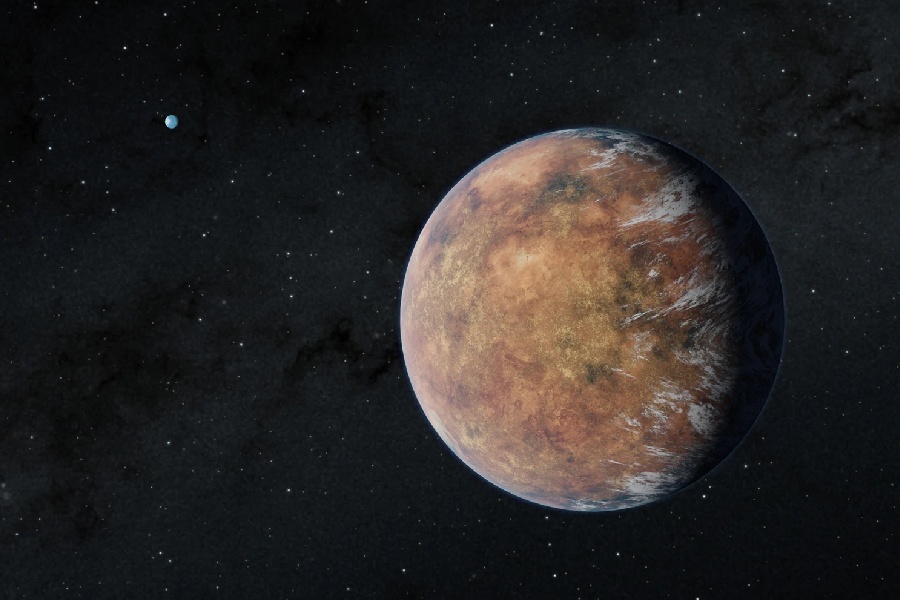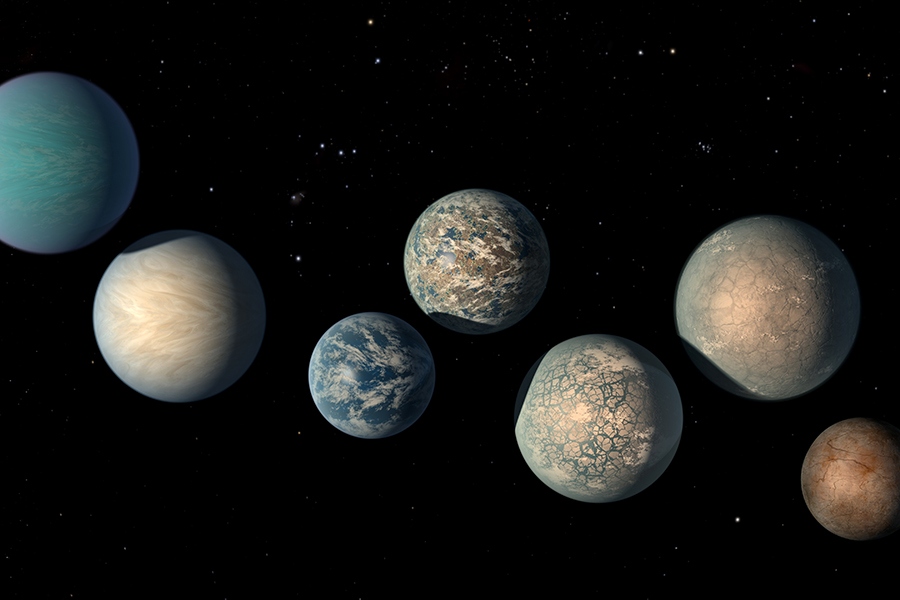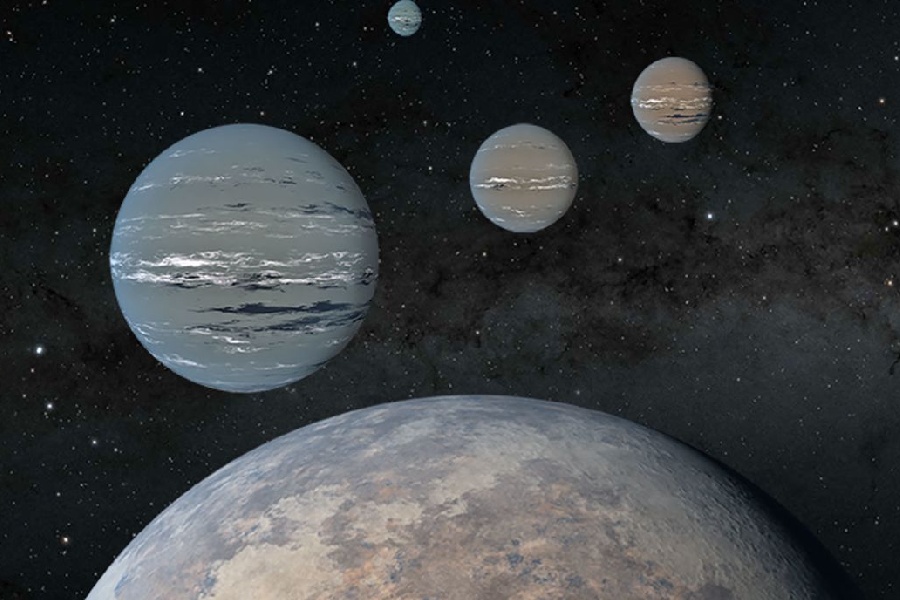The confirmation of the first exoplanet in 1995 sparked a revolution in astronomy, confirming that planetary systems exist beyond our tiny corner of the galaxy. Since then, thousands of exoplanets have been detected, showcasing many perplexing properties that defy assumptions. But what is an exoplanet?
In this article, we will explore the exoplanet definition. We will also look at how advanced techniques have enabled the detection of these distant worlds across vast interstellar distances.
Also, we will examine the remarkable properties that different discovered exoplanet types exhibit. Finally, we will consider what the future may hold for characterizing potentially habitable, life-hosting worlds.
Let’s get started!
What Is an Exoplanet?
An exoplanet, short for “extrasolar planet”, is a planet located outside our solar system, orbiting a star other than the Sun. There are different techniques to discover exoplanets.
One is the transit method, which observes the dimming of a star’s light. Another is the radial velocity method, which detects a star’s wobble from the planet’s gravity. Direct imaging of the planet is also used to find exoplanets.
Exoplanets come in diverse sizes, compositions, and orbits. Also, their study is crucial for understanding the broader cosmic landscape and the potential for extraterrestrial life beyond our solar system.

The Basics of Exoplanets
Formation of exoplanets
What are exoplanets made of? Exoplanets form through a complex interplay of gravitational forces and protoplanetary disks within star systems. The process typically begins in stellar nurseries, where massive clouds of gas and dust collapse under their gravity, forming a central star.
The remaining material in the protoplanetary disk starts to aggregate into planetesimals, which eventually collide and merge to create protoplanets. These protoplanets grow by accreting gas and dust until they reach a critical mass, becoming fully-fledged exoplanets.
The diversity in exoplanet compositions and sizes stems from variations in their formation environments and the materials available in the protoplanetary disk.
Abundance of exoplanets
Exoplanets are astonishingly abundant in the universe, contributing to the vast cosmic tapestry. The prevalence of exoplanets challenges the notion that our solar system is unique in hosting planets.
Recent observational data from missions like Kepler and TESS suggest that many stars in our galaxy may harbor exoplanets. The sheer abundance of these planets expands our understanding of planetary systems, highlighting their ubiquity in the cosmos.
Exoplanets are crucial in shaping our comprehension of stellar evolution and the conditions conducive to planet formation. They also contribute to our understanding of the potential for life beyond our solar system.
Their abundance also underscores the importance of continued exploration and research. This is crucial to unlock the mysteries of these distant worlds and understand their role in the grand cosmic narrative.
Methods of Detection
Transit method
The transit method is a powerful technique scientists employ to detect exoplanets by observing the slight dimming of a star’s light as a planet passes in front of it. This periodic dimming, or transit, provides crucial information about the exoplanet, such as its size, orbital period, and distance from its host star.
The Kepler space telescope, for example, has utilized this method to identify thousands of exoplanet candidates. It significantly contributes to our understanding of the prevalence and diversity of planets beyond our solar system.
Radial velocity
The radial velocity method involves measuring the tiny wobbles or shifts in a star’s spectral lines caused by the gravitational tug of an orbiting exoplanet. As a planet orbits its host star, the star itself moves in response to the gravitational influence of the planet.
By analyzing the periodic changes in the star’s radial velocity, scientists can deduce the presence, mass, and orbital characteristics of the exoplanet. This method has been instrumental in identifying various exoplanets, including those with different masses and distances from their host stars.
Direct imaging
Directly imaging exoplanets is a challenging but increasingly promising method that captures the faint light emitted or reflected by the planet itself. The primary obstacle lies in the vast brightness contrast between the relatively dim exoplanet and its much brighter host star.
Advanced technologies, such as adaptive optics and coronagraphs, have been developed to mitigate this contrast and enhance our ability to directly image exoplanets.
So, breakthroughs in this method have allowed scientists to study the atmospheres and physical characteristics of some exoplanets. It offers valuable insights into their compositions and potential habitability.

Diversity of Exoplanets
Hot Jupiters and Super-Earths
The universe is teeming with a diverse array of exoplanets, each with its unique characteristics. Two notable types are Hot Jupiters and Super-Earths.
Hot Jupiters
These are gas giant exoplanets with masses similar to or greater than Jupiter, but they orbit their host stars at incredibly close distances. Their proximity to the star results in scorching temperatures, making them inhospitable for life as we know it.
Despite their hostile environments, the study of Hot Jupiters has provided valuable insights into planetary migration and the dynamic processes shaping planetary systems.
Super-Earths
Super-Earths are rocky exoplanets with masses larger than Earth but smaller than Uranus or Neptune. These planets come in various compositions and may have diverse surface features.
Some Super-Earths may have thick atmospheres or even oceans. This raises intriguing questions about their potential habitability and the range of planetary conditions beyond our solar system.
Habitable zone planets
One of the most compelling areas of exoplanet research is the search for planets within the “habitable zone” of their host stars. But are exoplanets habitable? The habitability of exoplanets depends on various factors, including their size, composition, distance from their host star, and the presence of an atmosphere.
Habitable zone
Also known as the Goldilocks zone, this region is characterized by conditions suitable for liquid water to exist on a planet’s surface. This is a crucial factor for the emergence of life as we know it.
Hence, the search for exoplanets within the habitable zone is driven by the quest to find environments potentially supporting life.
Potential for life
Identifying exoplanets within the habitable zone does not guarantee the presence of life. However, it signifies conditions where life, as we understand it, could thrive.
Scientists use various observational methods to analyze the atmospheres and compositions of these planets. They are looking for signs of habitability, such as water vapor or other biomarkers.
Notable Exoplanet Discoveries
Kepler-186f
Among the notable exoplanet discoveries, Kepler-186f holds a special place. Discovered by NASA’s Kepler Space Telescope, Kepler-186f is located in the habitable zone of its host star, Kepler-186, approximately 500 light-years from Earth.
What makes Kepler-186f particularly significant is its size and location. It is a rocky exoplanet only slightly larger than Earth, suggesting the possibility of a solid surface.
Its position within the habitable zone raises intriguing questions about the potential for liquid water and, by extension, the conditions suitable for life. Kepler-186f symbolizes the ongoing quest to identify Earth-like exoplanets and understand the diversity of planetary environments in the cosmos.
TRAPPIST-1 System
The TRAPPIST-1 system is a remarkable discovery featuring seven Earth-sized planets orbiting a small, cool star called TRAPPIST-1. This exoplanetary system gained widespread attention due to its unique characteristics and potential for habitability.
The TRAPPIST-1 system is a treasure trove for exoplanet researchers. Its seven planets are tightly packed, and several reside within the star’s habitable zone. This proximity allows scientists to study the atmospheres of these planets in detail, paving the way for insights into their compositions and potential habitability.
The discovery of TRAPPIST-1 exemplifies the technological advancements in exoplanet detection. It also highlights the prospects of finding potentially habitable worlds beyond our solar system.

Challenges in Exoplanet Research
Detection limitations
- Immense distances make exoplanets appear extremely faint and difficult to detect. For example, an exoplanet 1,000 light years away would appear 10 million times fainter than the star it orbits.
- The brightness of the parent star can obscure an exoplanet. Separating a dim planet’s signal from the glare of the star it orbits presents major obstacles.
- Small planet size and low mass make detection difficult. Current methods are limited in finding Earth-sized exoplanets and less massive worlds.
- Orbital alignment affects detectability. Edge-on orbits along our line of sight are easier to detect versus face-on orbits.
- The lack of suitable vantage points limits direct imaging. Exoplanets must be sufficiently far from their stars for direct imaging.
Characterization difficulties
- Distance severely limits data collection and quality of spectroscopic measurements.
- Parent star brightness complicates obtaining clean spectral data on exoplanet atmospheres and surfaces.
- Limited technology restricts characterization scope. Next-generation space telescopes and instruments are needed to analyze exoplanet atmospheres.
- Planetary evolution modeling remains imperfect. Better models of planet formation and evolution are needed to interpret composition data.
- Single exoplanets studied in isolation provide limited insights. Characterizing full planetary systems is crucial but highly difficult.
Frequently Asked Questions
Can we live on exoplanets?
The habitability of an exoplanet depends on various factors, including its distance from its host star, composition, and atmosphere. As of now, scientists focus on identifying exoplanets within the habitable zone where conditions may allow for liquid water.
However, the feasibility of human habitation on exoplanets remains speculative. Technological and environmental challenges must be addressed before considering the possibility of living in these distant worlds.
What are the three types of exoplanets?
Exoplanets can be broadly classified into three types based on their characteristics. Hot Jupiters are gas giants located close to their host stars. Super-Earths are rocky planets with masses larger than Earth. Ice Giants are similar to Uranus and Neptune.
Each type provides valuable insights into the diversity of planetary compositions and environments within our galaxy.
How many exoplanets are there?
The number of known exoplanets is continually increasing as technology advances. As of the latest count, thousands of exoplanets have been discovered, with many more awaiting confirmation.
Space telescopes like Kepler and TESS have significantly contributed to this count, revealing the abundance and diversity of planets beyond our solar system.
When was the first exoplanet discovered?
The first confirmed discovery of an exoplanet occurred in 1992 around the pulsar PSR B1257+12. However, the first discovery of an exoplanet orbiting a main-sequence star (similar to our Sun) was made in 1995 by astronomers Michel Mayor and Didier Queloz.
The exoplanet, named 51 Pegasi b, marked a groundbreaking moment in astronomy and opened the door to the vast field of exoplanet exploration.
Conclusion
What is an exoplanet? As thousands of exoplanets continue being discovered across the galaxy, each new world challenges preconceived notions and expands the known cosmic inventory. This overview has highlighted some remarkable exoplanets, from scorching Hot Jupiters to potentially habitable super-Earths.
The incredible diversity of exoplanets unveiled in recent decades has illuminated worlds beyond imagination. We hope this article has conveyed the remarkable nature of exoplanets, which continuously reshape concepts of what kinds of cosmic habitats may exist in the galaxy.
